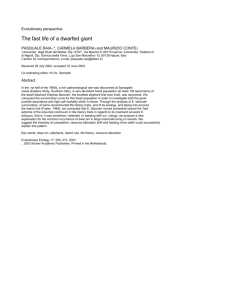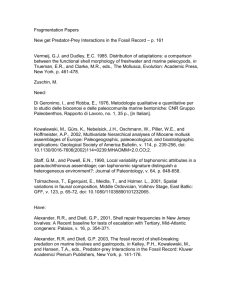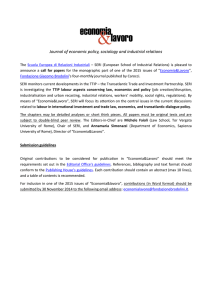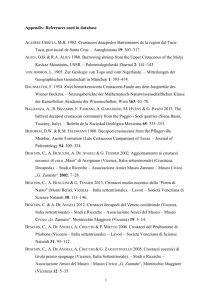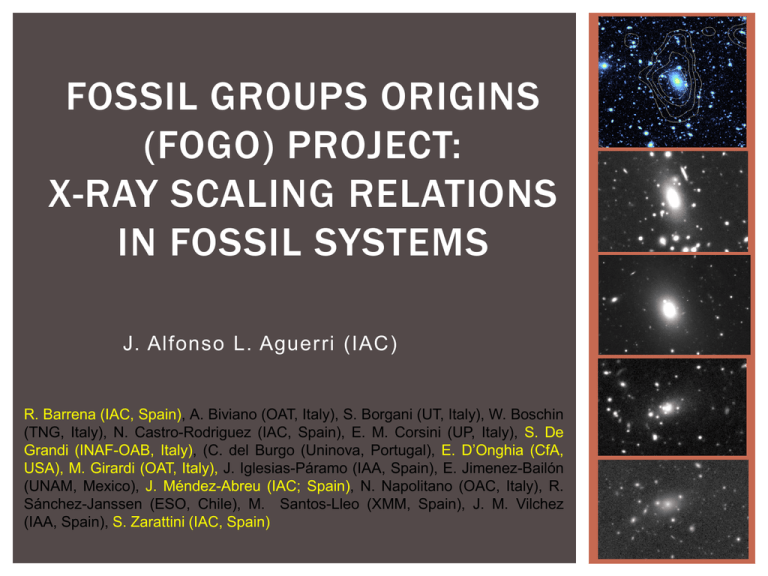
FOSSIL GROUPS ORIGINS
(FOGO) PROJECT:
X-RAY SCALING RELATIONS
IN FOSSIL SYSTEMS
J. Alfonso L. Aguerri (IAC)
R. Barrena (IAC, Spain), A. Biviano (OAT, Italy), S. Borgani (UT, Italy), W. Boschin
(TNG, Italy), N. Castro-Rodriguez (IAC, Spain), E. M. Corsini (UP, Italy), S. De
Grandi (INAF-OAB, Italy), (C. del Burgo (Uninova, Portugal), E. D’Onghia (CfA,
USA), M. Girardi (OAT, Italy), J. Iglesias-Páramo (IAA, Spain), E. Jimenez-Bailón
(UNAM, Mexico), J. Méndez-Abreu (IAC; Spain), N. Napolitano (OAC, Italy), R.
Sánchez-Janssen (ESO, Chile), M. Santos-Lleo (XMM, Spain), J. M. Vilchez
(IAA, Spain), S. Zarattini (IAC, Spain)
WHAT IS A FOSSIL SYSTEM?
Ponman
et
al
(1994)
discovered the galaxy RX
J1340.6+4018 an elliptical
galaxy dominated system.
The elliptical galaxy was
surrounded by an X-ray
emitting halo of hot gas
suggesting a large amount
of dark matter
This was interpreted as an
evolved group of galaxies.
The central galaxy has eaten
all L* galaxies arround.
WHAT IS A FOSSIL SYSTEM?
The obser vational definition of these systems was given by Jones et al.
(2003)
RX extended emission with Lx>10^42 erg/s
Magnitude gap between the brightest and the second brightest galaxies:
m1-m2>2 in the R filter
Recently: m1-m4>4.5 (Dariush et al. 2010)
Are these systems impor tant?
These systems are as common as poor and rich galaxy cluster s
together: n ∼ (1 − 4) × 10−6 h−3 Mpc−3 (Vikhlinin et al. 1998; Jones
et al. 2003; Santos et al. 2007; La Barbera et al. 2009; Voevodkin et
al. 2010).
They hosts the most massive and luminous galaxies in the Universe.
The formation of these streme objects could be challenge for structure
formation models.
Fossil systems could be a challenge for structure formation models.
They could show one order to magnitude less substructure than
predicted by CDM theor y (see D’Onghia & Lake 2005; But see also
Zibetti et al. 2010).
TWO FORMATION SCENARIOS
One interpretation is that they represent the end product of
galaxy merging in group or clusters (D’Onghia & Lake
2005; von Benda Beckman et al. 2008; Sommer-Larsen
2006; Dariush et al. 2010)
Other formation scenario suggest that Fossil Systems are
systems formed as deficient in L* galaxies.
This formation scenario suggest that fosill systems are
“failed groups or clusters” (Mulchaey & Zabludoff 1999;
Proctor et al. 2012).
In these systems the majority of of the availabe gas was
initially used in the formation of the central galaxy rather
than in several with intemediate luminosity.
FOSSIL GROUPS ORIGINS
(FOGO PROJECT)
In 2008 only ~10 fossil systems were analyzed (Ponman et al.
1994; Jones et al. 2003; Méndez de Oliveira et al. 2006;
Khosroshahi et al. 2006, 2007)
These small samples do not provide strong conclusions about
the origin and evolution of these systems.
New sample of fossil systems were discovered increasing the
old ones. Special interest the sample fro SDSS-DR5 (Santos
et al. 2007). This is a unique sample:
Evolution of fossil groups during the last 6 Gyr
Large range of Lx luminosities (Lx= [10^42, 10^44] erg/s)
Large range of magnitudes of the BGGs (Mr=[-21.5,-25.5])
We proposed a project in order to study systematically this
large sample of 34 FGs.
FOGO PROJECT
ITP programm: We obtained 52 observing nights in the
perios 2008-2010 at: 4m WHT, 2.5m INT, 3.8m TNG,
and 2.5m NOT
Available database:
Optical imaging: Deep r-band
images of 34 FGs, limiting surface
brightness ~28 mag/arcsec 2 . Limiting magnitude ~23 in r-band.
Instruments: ALFOSC at NOT and WFC at INT
Near-Ir imaging: Deep K-band
images for 20 FGs. Limiting surface
brightness ~21 mag/arcsec 2 and limiting magnitude ~19.5 in K-band.
Instrument: LIRIS at WHT
Multiobject spectroscopy: for 28 FGs. We expect ~1000 members.
Instruments: WYFOS at WHT and DOLORES at TNG
Integral spectroscopy for 9 groups. Instrument: INTEGRAL at WHT
Xray data observations: 6 objects from XMM and Chandra
archives. SUZAKU data for 10 objects for global X-ray
properties (Lx, Tx).
FIRST FOGO RESULTS IN THE OPTICAL
AND NEAR-INFRARED
Aguerri et al. 2011, A&A, 527, 143
Méndez-Abreu et al. 2012, A&A, 537, 25
X-RAY SCALING RELATIONS
We will show in this talk the FOGO results on X-ray scaling
relations in fossil systems. In particular, we will show the
relations concerning:
1.- Lopt-LX relation
2.- LBCG-LX relation
X-RAY SCALING RELATIONS: L OPT -L X
Khosroshahi et al. 2007
Harrison et al. 2012
Fossil and non-fossil systems show similar scaling relations involving Lx and
Tx (Khosroshahi et al. 2007; Voevodkin et al. 2009; Proctor et al. 2012;
Harrison et al. 2012).
X-RAY SCALING RELATIONS: L OPT -L X
K o s r o s h a h i e t a l . ( 2 0 0 7 ) fo un d t h at F G s
s h ow s d i f fer e nt Lx - Lr r el at i o n t ha n n o n - fo s s i l
s y s tem s . T h ey in te rp r eted as FG s a r e mo r e
l u m i n o u s i n X - r ay t h a n no n - fo s s i l fo r a g i v e n
L r. D i f fer e nt g r av i t at i o n al p ote nt i al (m o r e
c u s py ) d u e to e a r l y f o r m a t i o n .
P r o c t o r e t a l . (2 0 11 ) al s o fo u nd a n o f f s et o f
F G s i n t h e Lx - Lr r el at i o n . N ev er t h el e s s t hey
i nterp r eted a s FG s a r e d e f i c i e n t i n o p t i c a l
Kosroshahi et al (2007) l u m i n o s i t y fo r a g i v e n Lx “ f ai l ed g ro up s o r
c l us te r s ”
Voevodkin et al. (2009) and
Harrison et al. (2012) found no
difference between fossil and nonfossil systems in the Lx-Lopt relation.
Harrison et al. 2012
Voevodkin et al. (2009)
X-RAY SCALING RELATIONS: L OPT-L X
Our results on the Lx-Lopt relations using the
34 FGs candidates from Santos et al.
(2007).
For comparison: the RASS-SDSS galaxy
cluster survey. This consists on 114 nearby
galaxy systems covering a large range of
masses (Popesso et al. 2004).
We take care to apply homogeneus
procedures to these FGs and the
Comparison cluster sample We computed
Fully
consistent
Lx
and
Loptical
luminositites.
The X-ray luminosities were recomputed from
ROSAT counts rates (Voges et al. 1999,
2000). We took into account the Total
Galactic HI column Density. We used a
procedure based on PIMMS using X-ray APEC
models with Z=0.4 Z_sun
The optical luminosity is given
by
¥
Loptical = Lcorr + F* L*
Girardi et al. 2012, in prep
Lcorr =
å (L
gal
L<LLim
ò
Llim /L*
x1+a e- x dx
- Lback )
X-RAY SCALING RELATIONS: L OPT -L X
No significant differences
have been observed between
Fossil and non-fossil systems
in the Lx-Lopt plane.
For a given Lx Fossil systems
show
similar
optical
luminosity within R500 than
non-fosill systems.
Girardi et al. 2012, in prep
X-RAY SCALING RELATIONS: L BCG -L X
Lin & Morh (2004) found a
correlation
between
the
luminosity of the brightest
cluster galaxy (BCG) and the
mass of the host cluster.
They conclude that BGCs in
clusters grow by merging
other galaxies as the host
clusters grow hierarchically.
They expeculate with the
position of Fossil systems in
the L BCG -L X plane.
Lin & Morh 2004
X-RAY SCALING RELATIONS: L BCG -L X
Recently, Harrison et al.
(2012) has observed that
BCGs in fossil systems are
located
in
the
upper
envelope of the L BCG -T X
relation.
For a fixed T X BCGs in Fossil
systems are more massive
than BCGs in non fossil
ones.
Harrison et al. 2012
X-RAY SCALING RELATIONS: L BCG -L X
We have anal yzed the di sper si on of
the L X -L BCG rel ati on as a functi on of
m 1 -m 2.
We have co mputed the absolute
magnitud of the central galaxies
and the L x o f the systems in an
homogeneus way. Thus, M r was
obtained from SDSS and L X from
ROSAT counts rate.
We have taken a large sample of
fossil s ys tems from the literature :
Mendes de O liveira et al . (2009 ),
Adami et al . (2010 ); Harris on et al .
(2012 ); Khos roshahi et al. (2007 );
La Barbera et al . (2012); Miller et
al. (2012 ); Proc tor et al . (2012 );
Santos et al. (2007)
Aguerri et al. 2012, in prep
X-RAY SCALING RELATIONS: L BCG -L X
Similar resul t is obtained in the
M star -L X plane
Most of the BCGs i n fossil systems
are more massive for a fi xed L X
than those in non-fossil ones.
There is a fracti on (about 30%) of
fossil systems showing BCGs with
smaller mass (lumi nosity ). Similar
to cluster s with small m 1 -m 2
The most massive BCGs can be
explained by merger s of galaxies .
Never theless , the less massi ve
ones not
We can expeculate that there are
two kinds of fossil s ys tems : Those
formed by merger s and those
which could b e “failed cluster s ” or
systems with dif ferent merging
histor y.
Aguerri et al. 2012, in prep
CONCLUSIONS
The FOGO project is a multiwavelength study of fossil galaxy
systems in order to study the properties of the BGGs and the
galaxy population of these systems
We have investigated the L opt -L X and L BCG -L X relations in our
fossil systems
The distribution of our fossil systems in the L opt -L X plane is
similar than non-fossil ones. Thus, fossil systems do not show a
deficient optical luminosity for a given L x luminosity of the host
cluster.
In general, for a given L X, the brightest cluster galaxies in fossil
systems are more massive than in non-fossil ones.
There is a fraction (30%) of fossil systems showing less
massive central galaxies. These galaxies can not be explained
by transformation of non-fossil in fossil systems by mergers.
These results probably indicate several origins for fossil
systems


